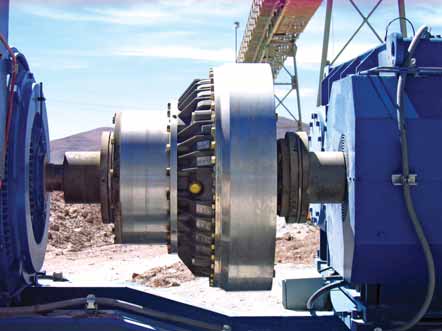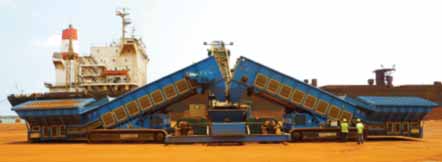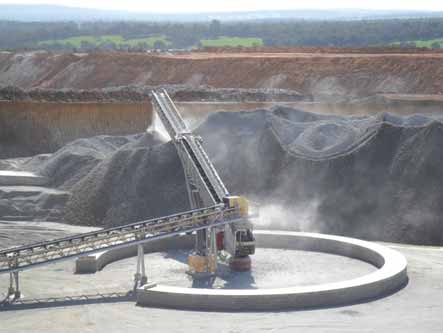Conveyors have been a part of global industrial activity for more than a century, and
their use in various mining applications has
grown exponentially over roughly the same
time frame. Driven by a bedrock economic
mandate to move more material at a faster
rate—and preferably at steadily lower cost
per ton—the global mining industry has
leaned heavily on bulk materials handling
technology to meet its production and
product-delivery targets. Conveyor-system
vendors have, in turn, implemented the latest advances in automation, power transmission and real-time condition monitoring
to provide increasingly capable, powerful
and flexible systems.
The growing sophistication of conveyor
control systems and variable speed drives
offers improved fine-tuning of startup
sequences and operational speeds, allowing
mines to more closely match belt throughput to upstream conditions and processes,
while saving energy and reducing unnecessary mechanical wear. The ability to adjust
conveyor performance to meet evolving
requirements as a mine passes through its
startup phase to maturity, without need of
major system upgrades or modifications—
and while cutting maintenance costs and
extending component service life—offers a
powerful incentive for increased industry
investment in new, large-scale conveyor
technology. And, based on examples
described below involving two major producers—Vale and Codelco—that incentive
appears to be effective.
Industry suppliers are also steadily introducing new, more specialized bulk handling
products that give mine operators a wider
range of options to meet site-specific challenges. These range from pipe conveyors
that can eliminate dust and spillage, to
high-angle belt or bucket systems. At the
end of the conveyor run, new self-powered
and highly maneuverable feeders and conveyor units provide increased mobility and
flexibility in stockpile and loading applications at lower capital costs when compared
with traditional stationary equipment.
Trading Trucks for Belts
Vale, the world’s largest iron ore producer,
announced in early July that it had obtained
the installation environmental license for its
S11D iron ore development project in the
Carajá s region of Brazil. Following issuance
of the license, Vale’s board of directors
approved full development of the S11D
project. The project has a nominal capacity
of 90 million metric tons per year (mt/y) of
iron ore and is the largest mine development project in Vale’s history.
According to the company, a conventional truck/shovel mining operation of this
size would require roughly 100 haulage
trucks. Instead, by using a “truckless”
approach that employs in-pit crushing and
conveying, Vale said it will reduce both its
diesel fuel consumption and its annual
CO2
emissions from the operation by 77%.
 A worker checks rolls of conveyor belting onsite at Vale’s S11D iron ore project in Brazil. The mine, which
A worker checks rolls of conveyor belting onsite at Vale’s S11D iron ore project in Brazil. The mine, which
ranks as the largest mine development project in the company’s history, will use 37 km of belting in a
large-scale IPCC mining operation. (Photo courtesy of Vale)
The use of a conveyor system allows the
processing plant to be built on pasture land
outside the forest where the mine is located, reducing the operation’s deforestation
impact.
Vale awarded SKM a $74-million implementation contract for engineering the
in-pit crushing and conveying (IPCC) system at S11D. In all, 37 km of conveyor
belts will be installed within the mining
area, including branches that will connect
to the main trunk line feeding the processing plant. The maximum distance between
the ore collection point and plant will be
15 km. The system will use shovels to feed
mobile crushers that will in turn feed the
belts. The mine’s primary equipment will be powered exclusively by electricity. Only
crawler tractors, motor graders and other
auxiliary machines will run on diesel.
The site challenges are enormous:
Inside the pit, 2,000-mt mobile mining
machines and 2-km-long conveyors will be
moving with and around each other, while
also working around the drilling, blasting
and mining operations. When installed, the
system’s transfer conveyors will run
through rugged terrain, dropping 400 m in
elevation from the pit to the dumps over a
distance of 4 km while carrying 9,000
mt/h—a volume that SKM equates to having two family-size sedans dropping off the
terminal point of the belts every second.
Going Gearless at El Teniente
Earlier this year, Chilean state-owned
copper producer Codelco announced that it
planned to spend more than $5 billion in
capital expenditures during 2013, up from
almost $4.2 billion in 2012. Approximately
$2.29 billion of the 2013 total will
go toward three major development projects: $1.155 billion for the new Ministro
Hales mine, $716 million for new mine
level development at El Teniente, and
$417 million for the Chuquicamata underground project.
At the El Teniente expansion project,
work on a new mine level during 2013 will
focus on mine development and excavation
of the two primary access tunnels—one for
use by employee transport buses and the
other for the ore conveyor belt, a service
track, and an alternative emergency exit.
The new level is scheduled to produce
137,000 mt/d of ore and 430,000 mt/y of
fine copper, maintaining existing capacity
at the mine. An option remains open for
later expansion to 180,000 mt/d. The project will extend mine life at El Teniente by
50 years following startup in 2017.
Codelco awarded a contract for an
essential part of the expansion project—a
large-scale conveyor system to connect the
new orebody to the processing facilities—to
Tenova Mining & Minerals TAKRAF unit. In
its final stage, the system will transport primary crushed copper ore at more than
12,000 mt/h. Running at 6 m/sec, the 2-m-wide belt conveyor system will carry ore
almost 12 km to the plant. Three principal
conveyors—one 9,000-m-long tunnel conveyor and two 1,000-m-long inclined conveyors—will feed the existing stockpile and
in the future, a new stockpile.
TAKRAF said that, with an eye on current and future energy costs, Codelco determined that drive efficiency and conveyor
running resistance were increasingly important system characteristics, and consequently selected gearless drives with highefficiency variable speed control for the
conveyor system. The gearless approach
will allow the El Teniente operations to initially run the conveyor system at slower
speeds to suit the lower conveying demands
in the earlier years of production, thus saving power, reducing wear and providing
additional savings in maintenance costs.


Tunneling equipment is in place at Codelco’s El Teniente mine for construction of an almost 9,000-m long conveyor path leading to the existing mill (right).
In its final stage, the system will transport crushed ore at more than 12,000 mt/h, running at 6 m/sec.
Although gearless or direct drives are a
proven technology that has been used in
mills and hoists for years, it is a relatively
new approach in conveyor design. TAKRAF,
in partnership with ABB, said it has integrated features within gearless drive systems aimed at reducing maintenance work
in the field to a minimum, allowing a faulty
drive to be quickly removed and replaced,
and then repaired in the shop, and allowing easy alignment once installed. Gearless
drive units can transmit strong and sometime damaging force to conveyor components—a condition that has caused problems with pulleys in the past. However,
TAKRAF maintains that the system design
eliminates this risk and allows the use of
standard pulleys throughout the system.
TAKRAF pointed out that the long tunnel conveyor is designed to minimize running resistance by ensuring accurate alignment through the use of special conveyor
frames and low-resistance rubber compound for the belt. The two steep inclined
conveyors, which in their final stage will
both be equipped with four 2,500-kW
drives, also presented some challenges
involving maintenance of idler rolls along
the conveyor run, most of which is enclosed
in tunnels. TAKRAF developed a unique
system to service these steep conveyors.
Manual handling of conveyor rolls,
which can weight 45 kg or more, is difficult and carries a high risk of injury for
maintenance personnel. The El Teniente
system will employ a special maintenance
cart equipped with a small service crane,
which will run on rails along the entire conveyor length and straddle the belt. The
crane is fitted with lifting frames, allowing
the maintenance workers to guide the roll
while its weight is handled by the crane.
The cart can carry spare rolls, all required
tools and up to four people.
The ABB drive system is designed to
feed power back into the grid during electrical braking and regenerative operation.
Beginning in the third quarter of 2013,
ABB will deliver electrical equipment and
new gearless drive technology (with 12,
2,500-kW/56 rpm motors) for the complete conveyor system. ABB will also provide E-houses with pre-installed equipment, air conditioning and liquid cooling
for the ACS6000 drives and synchronous
motors, along with its MCCP mining conveyor control program for main drive control and load sharing, and its 800xA
Extended Automation System.
 Controlled application of fluid coupling torque provides a smooth start-up to protect conveyor belts from
Controlled application of fluid coupling torque provides a smooth start-up to protect conveyor belts from
stress
damage, according to Voith Turbo. Shown here is a version of Voith’s TVVS fluid couplings; the
company recently
delivered 36 of these couplings for installation in an offshore iron ore distribution
terminal in Malaysia.
From Ship to Shore
Germany-based Beumer Maschinenfabrik
noted that its curved belt conveyors are available in open troughed belt-conveyor configurations for higher throughputs and larger
mass flows as well as larger curve radii, and
in enclosed pipe conveyors for products that
need protection from environmental factors.
Beumer said it is currently installing
several pipe conveyors with a total length of
about 3 km for transporting copper, lead
and zinc concentrates at the port of Callao
in Peru, scheduled for completion in 2014.
In Malaysia, Beumer is equipping Vale’s
new off-shore distribution center with 17
troughed belt conveyors with a total length
of 12 km. The conveyors will transfer iron
ore from super-size freighters to shore.
Voith Turbo, a division of Voith GmbH,
recently delivered 36 hydrodynamic fluid
couplings to Beumer for the Malaysian
project, where the couplings will be used in
drives rated at 200 to 800 kW. The TVVStype couplings supplied to Beumer,
according to Voith, feature special TVVS
designs to match the start-up and operating conditions of the drives.
Voith said the TVVS constant-filled fluid
coupling is particularly suited for medium
to long belt conveyors. Because of the
mechanical separation of the motor and
machine through the fluid coupling, the
motor can run up to speed without load.
The application of fluid coupling torque
provides a smooth start-up to protect the
belt from stress damage.
In addition, systems that use multiple
motors can be switched on in a staggered
sequence to limit the current demanded
during the motor acceleration. This avoids
grid overloading caused by simultaneous
motor starts. In the most demanding belt
conveyors, TVVS couplings are fitted with
centrifugal force valves to further protect
the electric grid; these valves control the
filling and draining of the coupling working circuit, and thus the power transmission, as a function of the drive speed. The
motor starts up virtually load-free, even in
the event of voltage drops. The coupling
torque is applied continuously and without shocks up to the required breakaway
torque of the system.
The TVVS couplings can use water as
the operating medium, if necessary. This
environmentally friendly feature, said
Voith, is particularly well-suited for use in
the conveyors that transport iron ore over
the ocean’s surface.
On Track for Heavy-duty
Loading
Samson Materials Handling, now a part
of the Germany-based Aumund Group,
has introduced the latest variation of
the Samson Material Feeder—the trackmounted MF0814T series. The company
said the feeder’s concept was developed to
serve the needs of mining customers who
require a holding capacity of up to 50 tons
combined with operational durability and
accurate discharge control.
 Samson Materials Handling’s new track-mounted MF0814T Material Feeder is self-propelled and operates
Samson Materials Handling’s new track-mounted MF0814T Material Feeder is self-propelled and operates
via an
integrated diesel power supply. The series is designed for heavy-duty applications involving
continuous use.
The series is designed for heavy-duty
applications involving continuous use,
including high-impact loading from articulated dump trucks and large loading shovels. Suitable for materials with bulk density up to 2.6 t/m
3and lump sizes up to 400
mm, typical materials would include limestone, coal and coke, raw slag, alternative
fuels, clays and shale, and heavy ore types.
The MF0814T is self-propelled and
operates via an integrated diesel power
supply. With steering controlled through an
umbilical control, the unit can be deployed
quickly and independently, according to
the company.
Another division of Aumond Group—
Aumund Fördertechnik—announced in
2012 that it intended to focus more intently on the mining sector, and recently touted its new BW-L Twin-Chain bucket elevators as a product that can be well-suited for
specific, customized mining applications.
Aumund offers five different chain sizes
with bucket separations of 305 mm and 457
mm. The system, fitted with five-segment
sprockets, comprises a chain with a small
roller, a bulk material guide at the backs of
the buckets, a toothed drive ring, a nontoothed tensioning ring and bucket connector plates. The bucket elevators are designed
for speeds of 0.5 to 0.7 m/s and for a conveying capacity of 142 to 726 m3/h.
ContiTech’s Conveyor Belt Group displayed its new MegaPipe conveyor line at
the bauma 2013 trade show held earlier this
year in Munich, Germany. With an external
diameter of up to 900 mm, the new
MegaPipe line has double the capacity available from conventional closed-trough belts,
according to the company. Its design permits the inclination angle of a closed-trough
belt system to be increased by up to 45°,
depending on the bulk material properties.
The group also showcased its Flexowell
product line and Pocketlift steep-angle
conveyor system, described as the only
continuous conveyor systems available
for lift heights of up to 700 m and capacities of up to 5,000 t/h. After acquiring
the Flexowell and Pocketlift lines from
Metso in 2010, ContiTech announced in
September it had also acquired Metso’s
industrial conveyor belt operations based
in Helsinki, Finland. The transaction scope
includes a production plant in Kalkku,
Finland, where ContiTech will manufacture
conveyor belts for mining as well as other
industrial applications.
 A Telestack mobile radial conveyor at work in a stockpile operation.
A Telestack mobile radial conveyor at work in a stockpile operation.
Radial Units for Remote Sites
Many mining projects lack adequate
infrastructure to efficiently move the
mined commodity from pit to terminal or
port. As a consequence, according to
Telestack, a U.K.-based supplier of
mobile conveyor and feeder systems,
mine operators often have to invest in
costly infrastructure to facilitate transfer,
loading and shipping.
Telestack said it has designed, manufactured and installed a variety of self-powered mobile conveyors and hopper/feeders
that enable producers to stack and reclaim
material at the mine; load it onto a rail car
or truck for transfer to the port; unload,
stack and reclaim it at the port; and finally, load a barge or ship.
The company exhibited its mobile radial telescopic conveyors at bauma Africa
2013, held September 18-21 in Johannesburg, South Africa. Telestack representatives said it has a number of these units
already working in Africa, used for stockpiling/reclaiming at a pit or port and loading
vessels at river terminals and sea ports.
Vessels loaded range from barges up to
baby cape-size ships, and stockpile capacities can be as high as 400,000 tons of
ore with a standard system and even higher for customized applications, according
to the company.
Telestack said its Rapid Deployment
Solutions are currently handling a wide
variety of materials from heavy ores, to coal
to biomass, with transport rates of up to
3,500 tph, often in extreme conditions.
The product line’s mobile capabilities
provide a less expensive alternative to
mobile harbor cranes or stationary systems,
said Telestack, and require significantly
less civil engineering and infrastructure
costs. The machines are designed for continuous loading operations, and can run on
diesel hydraulic, power, diesel electric
power via onboard generators, or from onsite power sources. Being self-powered,
they can move around the mine or port
unassisted, eliminating the need for other
equipment to move them, and are claimed
to be capable of easily linking into existing
material handling systems.






